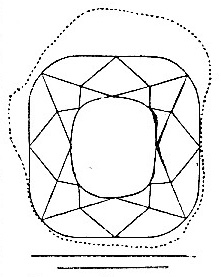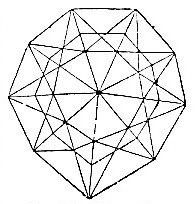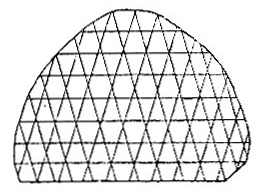1902 Encyclopedia > Diamond > Famous Diamonds
Diamond
(Part 8)
Famous Diamonds
Some diamonds are remarkable for their size or history. The largest undoubted is the Orloff in the scepter of the emperor of Russia, weighing 194 3/4 carats, and cut in the rose form, with a flat face below, resembling the half of a pigeon’s egg. According to one story, it formed the eye of an Indian idol, and was stolen by a French deserter; another is that it belonged to Nadir Shah of Persia, and on his murder came into the hands of an Armenian merchant, who brought it to Amsterdam. In 1772 it was sold to Count Orloff for the Empress Catherine for 450,000 silver roubles (£90,000), with an annuity of 4000 roubles and a title of Russian nobility.

Fig. 16 -- Pitt diamond
Second to it is the Regent or Pitt diamond (fig. 16), bought by Mr Pitt, the governor of Madras, in 1702, for about £20,000. He brought it to London, had it cut as a brilliant at, it is said, a cost of £3000, and sold it in 1717 to the regent duke of Orleans, for Louis XV., for 2 1/2 million francs, or £130,000; but it is estimated to be worth fully twice that sum. At the time of the first French Revolution it was sent to Berlin, but reappeared in the hilt of the sword of state worn by Napoleon I. It is considered as the finest and most perfect brilliant in Europe. It weighs 136 3/4 carats, but originally weighed 410 carats, and the fragments split or sawn from it when cut valued at some thousand pounds.

Fig. 17 -- Florentine
The third in weight is the Florentine, or Grand Duke, as it is named (fig. 17). It is of a fine yellow colour, oblong, and cut in rose. It is said to have been lost by Charles the Bold at the battle of Granson, and found by a Swiss soldier, who sold it for a few pence as a piece of rock crystal. It afterwards belonged to the grand duke of Tuscany, from whom it passed to the emperor of Austria. Its weight is usually given at 139 1/2 carats, but Schrauf finds its exact weight 133·16 Vienna carats, and its specific gravity at 19° C. 3·5213.

Fig. 18 -- Koh-i-Noor
The Koh-i-noor (fig 18), the largest belonging to the British Crown, has also a singular history, corresponding to that of the country of its origin. The Indian legend tells that it was found in one of the Golconda mines near the Kishna river, and worn 5000 years ago by Karna, one of the heroes celebrated in the Mahabharata. It passed through many hands to Baber, the founder of the Mogul dynasty, in 1526, and shown by his successor in 1665 to Tavernier, the French traveller. He describes it then as of the shape of a half egg, and weighing 280 carats, having been thus reduced by an unskilled stone-cutter from 793 5/8 carats, which it once weighed. In 1739 it passed to Nadir Shah, the Persian invader of India, who gave it the name of Koh-i-noor, or Mountain of Light, and from his successors in 1813 to Runjeet Sing, the ruler of Lahore. In 1849, on the annexation of the Punjab to British India, the Koh-i-noor was also surrendered and presented to the Queen in June 1850. It was exhibited in the Great Exhibition of 1851, and then weighed 186 1/16 carats, but has since been recut, with doubtful advantage, in the rose form, and is now 106 1/16 carats.
Its lower side is flat, and undoubtedly corresponds to a cleavage plane. Hence it has been conjectured that it and the Russian Orloff diamond are portions of the original stone belonging to the Great Mogul, whilst a stone of 132 carats, obtained by Abbas Mirza at the storming of Coocha, in Khorassan, in 1832, may be a third fragment. This portion was long used by a peasant as a flint for striking fire. The three united would have nearly the form and size given by Tavernier, and the Koh-i-noor would then surpass all known diamonds in its magnitude as in its eventful history.
It is not necessary to notice in detail other diamonds of smaller size, as the Sancy, of 53 1/2 carats, once the property of Charles the Bold, like the Austrian, and afterwards of Louis XIV of France, but sold in 1830 for £20,000 to the emperor of Russia.
In the Russian treasury are also the Shah of 86 carats, and the Polar Star of 40.
Other noted ones are the Nassac of 89 3/4 carats (now recut, and 78 5/8), the Piggot of 82 1/4, and the Pasha of Egypt of 40 carats, which cost £28,000.
Some are valued for other properties, as the Hope diamond, of a rare colour, a fine blue, and high brilliancy, estimated at £25,000, though only weighing 44 1/4 carats.
Red diamonds seem very rare, but there is a brilliant of 10 carats among the crown jewels of Russia, which cost £15,000, and in Dresden some very fine yellow stones, the largest of 29 1/2 carats.
Read the rest of this article:
Diamond - Table of Contents
|


